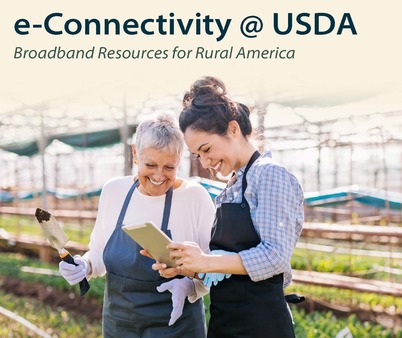|
Welcome to
the quarterly newsletter of USDA Rural Development in Oregon. Here, you will
find updates on funding opportunities and program activities through Business, Cooperative, Energy, Electric, Telecommunications, Water and Environmental, Community Facilities, Multi-Family Housing, and Single Family Housing programs.
We are pleased to announce the addition of two staff members who recently joined our Oregon team and will be helping to deliver housing assistance for rural Oregonians.

Christina Reese is a new Loan Technician at the Redmond office who will primarily provide assistance with the Multi-Family Housing programs. She has a Bachelor of Science in Social Science from Oregon State University.
Christina lives in Central Oregon with her husband, son, and four rescued Siberian huskies. In her spare time, her hobbies include wilderness hiking, spelunking, and kayaking.
You can reach Christina at christina.reese2@usda.gov or (541) 669-3189.
|

Cassy Inman is a new Pathways Intern working part-time at the Tangent office. She will primarily be assisting with the Single Family Housing programs.
Cassy is currently pursuing a Master’s Degree in Public Policy at Oregon State University. She has an undergraduate degree from the University of California, Santa Cruz, in Comparative Politics. Cassy grew up in Santa Cruz, California. She currently lives in Corvallis with her husband and young son.
You can reach Cassy at cassandra.inman@usda.gov or (541) 801-2689.
|
The U.S. Department of Agriculture (USDA) Rural Development is offering up to $600 million nationwide in loans and grants to help build broadband infrastructure in rural America through a new pilot program.
The ReConnect Program will help establish internet access in rural areas with a population of 20,000 or less that currently have insufficient broadband service. Telecommunications companies, rural electric cooperatives and utilities, internet service providers, and municipalities are eligible to apply.
The first round of applications will be accepted beginning April 23. Under this round, up to $200 million in grants will be made available. The application deadlines for each round are:
- May 31, 2019, for grant funding
- June 21, 2019, for combined loan and grant funding
- July 12, 2019, for low-interest loans
Those interested in applying are invited to join USDA in Welches, Oregon, for a technical assistance workshop to learn about the application process and program requirements. Pre-registration is required. We look forward to seeing you there!
Two additional programs are currently accepting applications to finance the expansion of high-speed internet access in rural areas.
The Rural Broadband Access Program provides loans of $100,000 to $25 million for the construction, improvement, or acquisition of facilities and equipment to provide high-speed broadband in rural areas. Priority will be given to projects extending service to the highest percentage of unserved households. Corporations, limited liability companies, cooperatives, state and local government entities, Native American tribes, and tribal organizations are eligible to apply.
For instructions on preparing a complete application, see the FY 2019 Application Guide. In addition, Rural Development offers pre-application assistance, including the review of draft applications, detailed feedback, and identification of areas where an application does not yet meet eligibility requirements.
Applications will be processed on a first-come, first-served basis. They will be reviewed and ranked every 90 days through September 30, 2019. Learn more…
The Community Connect Program provides grants of $100,000 to $3 million to help rural communities extend access where broadband service is least likely to be commercially available, but where it can make a tremendous difference in the quality of life for people and businesses. Awardees must also use their USDA funding to offer free broadband service to all critical community facilities and a community center in their proposed service area for two years. State and local governments, federally-recognized tribes, nonprofits, and for-profit corporations are eligible to apply.
Review the FY 2019 Application Guide for details on how to complete a successful application. The deadline to apply is April 15, 2019. Learn more…
 A new toolkit is now available to support the deployment of high-speed broadband in rural communities.
The e-Connectivity Toolkit features 27 USDA programs that support broadband deployment. This easy-to-use guide allows customers to identify the type of e-connectivity resources they need and locate assistance the Federal Government offers with planning, equipment, construction, research, and other e-connectivity projects.
Grants, loans, and technical assistance are available from multiple mission areas at USDA, including Rural Development, National Institute of Food and Agriculture, Farm Service Agency, Natural Resources Conservation Service, and Forest Service. View the toolkit online to learn more.
The Coquille Indian Tribe is increasing access to specialized medical care for Native Americans throughout southwest Oregon with the help of a $57,370 grant provided by USDA Rural Development through its Distance Learning and Telemedicine (DLT) Grant Program.
The Coquille Indian Community Health Center, located on the Kilkich Reservation near Coos Bay, Oregon, will establish a telemedicine system to provide improved access to specialized, professional medical care for approximately 1,300 rural residents.
By virtually connecting patients to medical specialists located hundreds of miles from the reservation, the telemedicine system will provide access to medical care that was previously unavailable at Kilkich, including treatment for substance abuse disorder, psychiatry, pain management, and dermatology. Learn more…
Rural Development can help with your next distance learning or telemedicine project. State and local governments, federally-recognized tribes, nonprofits, and for-profit businesses are invited to apply for grants to improve access to healthcare or educational services using broadband technology. Applications are due by May 15. Visit us online to learn more about the application process.
 Opioid addiction poses a monumental challenge across Oregon and the country, but especially in small, rural communities where prevention and treatment services are often under-resourced and difficult to access. USDA Rural Development is committed to being a strong partner for local leaders in combating this crisis.
We were honored to join eastern Oregon providers and communities in Pendleton last month to discuss local needs and find sustainable solutions at the Eastern Oregon Conference on Pain, Trauma, Addiction, Opioids & Other Drugs.
USDA has developed a suite of tools to help community leaders build grassroots strategies to address this epidemic, including:
Rural Development programs can provide financing to support a wide variety of substance use disorder prevention, treatment, and recovery services. From building new hospitals, to establishing transitional housing, to creating telehealth networks, and much more, USDA stands ready to partner with you. Learn how we can help by visiting our Resources for Substance Use Disorder and Opioid Misuse Prevention, Treatment, and Recovery in Oregon and contact us today to discuss your community’s needs.
USDA Rural Development and the U.S. Department of Health and Human Services (HHS) Substance Abuse and Mental Health Services Administration (SAMHSA) are partnering to create addiction recovery transitional housing in rural communities.
Under a memorandum of understanding formalized last month between USDA and HHS, nonprofits may now purchase real estate owned single family homes located in rural areas from USDA at a discount and convert them to transitional housing for people recovering from opioid misuse. The homes may also be used for treatment, job training, and other key services for people in substance misuse treatment and recovery.
This effort will further enhance the formal collaboration of our two agencies, which began in 2018 with SAMHSA supplementing USDA Cooperative Extension grants to expand technical assistance and training on opioid use disorder prevention and treatment. Learn more…
Housing was a constant concern for the Gonzalez-Weise family. They lived in a rental that was at the top end of their budget, but the roof leaked, and soon the house developed black mold.
They were ready for a new home that would be safe for their three-year-old son. They also wanted to finally make the leap into homeownership so they could start building equity and have better control over their home’s maintenance, but they couldn’t afford a down payment.
They applied to USDA Rural Development’s Single Family Housing Program. On their first day of house hunting, they found a three-bedroom home located on a quiet cul-de-sac in the rural town of Molalla in western Oregon. Their low-interest USDA mortgage, which has no down payment requirement, made it possible for them to buy the home.
Their monthly mortgage payment is only $115 more than they were paying on rent, and the additional amenities and safety of their new home make it well worth the cost.
“We had nothing, so this is a huge change for us,” said Georgia Weise. “If I can do it, anyone can.” Learn more…
Owning a home not only helps families build long-term financial stability, it also creates jobs, promotes community vitality, and stimulates the local economy. By offering low-interest loans with no down payment required, USDA Rural Development’s Single Family Housing programs can help rural residents buy, build, or repair a home when they are unable to qualify for conventional financing and cannot afford the higher costs of a traditional loan.
Find out if USDA’s Single Family Housing programs can help you make the leap into homeownership. Review our recently updated maximum loan limits for the Oregon county where you would like to purchase a home and then contact a local staff member to discuss your housing needs and eligibility.
Affordable rental housing for more than 100 low-income tenants will be preserved in southwest Oregon with the renovation and transfer to new ownership of three apartment complexes.
With help from $2.7 million from USDA’s Multi Family Housing Loan Guarantee Program, Catholic Charities of Oregon will extensively renovate three apartment complexes in the rural communities of Rogue River and Glendale. New roofs, siding, gutters, and windows will be installed. The complexes will be updated to meet current accessibility standards. Energy-efficient upgrades will be completed. Inside the apartment homes, the kitchens and bathrooms will be remodeled while flooring and appliances will be replaced as needed.
As part of the transfer to new ownership, Catholic Charities of Oregon will assume prior USDA Multi-Family Housing loans in the amount of $2.8 million. Additional funding is being provided by Oregon Housing and Community Services, Meyer Memorial Trust, and Federal Home Loan Bank.
Overall, this project will ensure rural families and seniors continue to have access to a safe, affordable place to live by preserving 102 units of affordable housing, continuing the availability of USDA rental assistance for 61 low-income residents, and improving the apartments and quality of life for the tenants.
In Oregon and across the nation, many children receive free or reduced-price breakfast and lunch while school is in session. However, when schools are out over the summer, many of the participating children are likely to have limited or no access to these two daily meals. Together, we can work to ensure that kids have access to food over the summer, too.
USDA’s Food and Nutrition Service serves free, healthy meals to eligible low-income children and teens during the summer months. Community facilities and multi-family housing complexes funded by USDA Rural Development often make ideal locations to host the Summer Food Service Program in rural communities. Those interested in learning more about serving as a meal site can find additional information online.
In Oregon, Partners for a Hunger Free Oregon and the Oregon Department of Education are the primary organizations in the state that can help establish new sites and offer additional support funds.
Join USDA in the fight against childhood hunger this summer! Apartment managers in Oregon may contact Faith Harris while community facility managers may contact Ella Nichols to learn more about serving as a meal site.
To find a summer meal site in your community, call (866) 338-6479 or visit the summer meal site finder.
The first ever Oregon Infrastructure Summit will be held on October 20-21, 2019, at the Salem Convention Center. The summit will focus on the interconnectedness of basic infrastructure—from broadband, to transportation, to water and wastewater infrastructure—and its importance in meeting community and regional economic development needs.
Hosted by Business Oregon with support from organizing partners, including USDA Rural Development, Oregon Department of Environmental Quality, Oregon Department of Transportation, Oregon Association of Water Utilities, Rural Community Assistance Corporations, and more, this will be a can’t-miss event.
Mark your calendars and watch for future announcements with additional details in the coming months.
The rural town of Mosier in northern Oregon is improving its municipal water system with the help of $1.4 million in funding from USDA Rural Development.
Mosier currently depends upon a single well to provide water to 269 households, 4 small businesses, a sewage treatment plant, and a school. Additionally, the community is planning to build a combined fire station, city hall, and community center that will also be connected to the municipal water system. However, the town’s water infrastructure does not have the capacity to meet increasing demand and lacks a backup water supply and systems.
With the help of a $763,000 loan and a $659,418 grant from USDA’s Water and Waste Disposal Program, Mosier will drill a new well that will serve as a backup water source. Additionally, the town will install a new telemetry system to improve efficiency and build a new pump station to provide backup power and redundant pumps. The new station will also expand the system’s capacity, ensuring sufficient utilities are provided to both existing customers and anticipated new residents.
Overall, this project will provide a sustainable groundwater supply, backup systems, and expanded capacity to ensure the 455 residents of this growing community continue to have access to the drinking water they depend upon. Learn more…
Neighbors for Kids was dependent on a single bus to transport children to its after-school and summer programs in Depoe Bay on the Oregon coast. However, the vehicle had reached the end of its useful life and periodically broke down, forcing the nonprofit to cancel activities.
Neighbors for Kids, which relies on financial support from the community to provide affordable after-school programs for working families, could not afford to replace its aging vehicle in addition to its day-to-day expenses.
The nonprofit applied to USDA Rural Development for assistance and was awarded a $44,000 grant through the Community Facilities Program. They used the grant to purchase two 12-passenger vans. The new vehicles ensure that children throughout the community can reliably travel to their after-school program while their parents continue to work.
"It really shows the partnership between a small nonprofit and our government," said Toby Winn, Executive Director of Resource and Development for Neighbors for Kids, "and how when we work together, in the end, the kids are the winners."
The residents of the rural community of Depoe Bay on the Oregon coast are no strangers to earthquakes. Most of the tremors they experience are small, but in the event of a major quake, they would depend on their local emergency responders for assistance. The 40-year-old, three-story Depoe Bay fire station, however, was outdated and no longer met the latest standards in seismic safety. Updating the building would be a significant undertaking, though, especially for this small, rural district.
With the help of a $1.8 million loan and a $74,900 grant provided by USDA Rural Development through its Community Facilities Program, as well as $831,318 from the state’s Seismic Rehabilitation Grant Program, the Depoe Bay Rural Fire Protection District was able to fully renovate Fire Station 2300.
This essential Depoe Bay facility is now seismically sound. During those critical repairs, the rest of the building was also updated. The building was made accessible for people with disabilities; a weight room and five additional bunk rooms were added; and the bays were widened to accommodate modern, larger vehicles.
The Depoe Bay Rural Fire Protection District now has the modern facilities it needs to continue serving this rural service area of 4,683 people and to provide a safe base of operations in the event of an earthquake. Learn more…
For years, John and Alayna Black dreamed about opening their own business. John worked as a mechanic, repairing cars, motorcycles, and boats, but it was a struggle to make ends meet, especially after Alayna’s back surgery. They had to start using food stamps so their family would have enough to eat.
The Blacks saw their opportunity when the rural town of Myrtle Point in southwest Oregon lost its only mechanic to retirement and the town’s sole tire store closed. They went to the bank and applied for a business loan, but they were denied.
Then they learned about a local nonprofit that operates a revolving loan fund seeded by USDA Rural Development through its Intermediary Relending Program. The fund provides financing to small and emerging rural businesses that are unable to qualify for a traditional bank loan. They applied and were approved for a $161,000 loan.
The Blacks purchased a derelict building that had been sitting empty for three years. Outlaw Auto opened in April 2018. Since then, they have hired two mechanics to keep up with demand, and they are providing on-the-job training to their second high school student, who works part-time after school.
Their family no longer worries about money, and they are happy to be providing jobs for additional members of their small community. Alayna says the most important lesson she has learned from this experience is “Don’t ever give up on your dreams.” Learn more…
Please join us in congratulating Brigham Fish Market on being featured by National Geographic. This family-owned business in Cascade Locks is the first Native American brick-and-mortar fish market in the Columbia Gorge.
This small, rural business opened its doors with the help of financing from a Mid-Columbia Economic Development District revolving loan fund that was seeded by USDA Rural Development.
Check out the National Geographic article “Why wild salmon remains king in the Pacific Northwest” to learn more about this local tribal business.
|